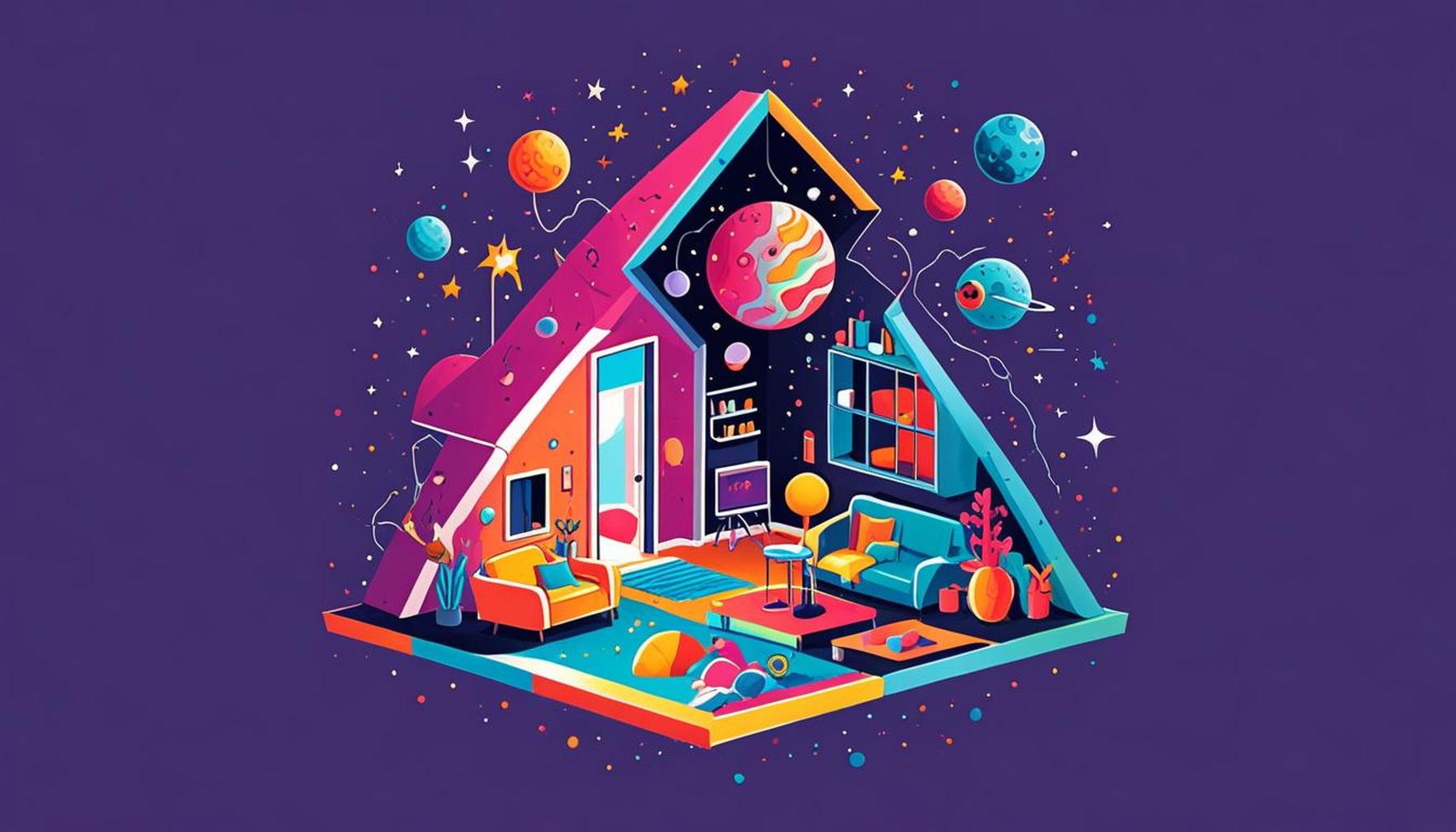The Psychology of Space: How Minimalism and Optimization Affect Well-Being

The Impact of Our Surroundings on Mental Well-Being
In today’s fast-paced world, the significance of our surrounding spaces has taken center stage. The way we curate our environments can profoundly influence our mental well-being and overall happiness. An increasing body of research reveals how our physical surroundings shape our psychological states, urging many individuals to reconsider how they design and interact with their environments.
Embracing Minimalism
Minimalism is a lifestyle choice that focuses on simplicity and the removal of excess clutter. This approach has gained traction, particularly in urban settings where space is often at a premium. By stripping away unnecessary items, individuals can reduce distractions and promote clarity and focus. For example, a study published in the Journal of Environmental Psychology found that participants engaged in minimalistic living reported improved concentration and a heightened state of relaxation compared to those surrounded by clutter.
Optimizing Space for Comfort
The optimization of space enhances comfort and efficiency, which in turn leads to greater productivity. In both home and work environments, strategically maximizing available space can minimize feelings of overwhelm. For instance, incorporating multifunctional furniture, such as sofas that convert into beds or desks with built-in storage, can create a versatile living area. When such designs are consciously implemented, they not only facilitate a streamlined lifestyle but also foster an atmosphere that encourages creativity and efficiency.
Designing for Emotional Impact
Strategically designed environments can evoke positive emotions, decrease stress levels, and promote overall well-being. Research shows that natural light, green spaces, and certain color schemes play significant roles in beautifying spaces and enhancing mood. For example, studies indicate that exposure to natural light improves energy levels and fosters a positive attitude, while colors like blue and green have calming effects on emotional states.
The Tiny House Movement
The rise of the tiny house movement illustrates the growing appeal of minimalism and efficient space utilization. Many individuals and families are choosing to downsize their living spaces, discovering that a smaller home allows for greater financial freedom and a lower environmental impact. This movement encourages many to connect with nature and prioritize experiences over material possessions. As participants embrace this lifestyle, they often report increased happiness and a newfound sense of purpose.
Conclusion
As we delve deeper into the realm of minimalism and space optimization, it is essential to explore how these concepts intertwine with psychological principles to shape our lives significantly. Reflecting on and managing our spaces thoughtfully can lead to profound transformations in mental well-being. Join us on this journey to discover practical ways to enhance well-being through intentional space management, and consider how small changes in your environment could lead to greater happiness and fulfillment in your life.
The Science Behind Clutter and Stress
Understanding the link between our environments and psychological health requires a look into the science of clutter. Numerous studies indicate that disorganized spaces can lead to increased levels of stress and anxiety. According to a study from UCLA’s Center on Everyday Lives and Families, homes filled with clutter may increase levels of the stress hormone cortisol among its inhabitants, thereby hindering emotional stability. When people live or work in cluttered environments, they often find it challenging to focus, which may lead to decreased productivity and heightened anxiety.
Furthermore, the overwhelming presence of physical clutter can mirror an internal chaos, creating a cycle where individuals feel unmotivated and paralyzed by their surroundings. Over time, this cycle can manifest into deeper issues such as feelings of inadequacy and decreased self-esteem.
Benefits of Minimalism in Daily Life
Minimalism promotes the idea of simplifying life by choosing quality over quantity. This intentional approach not only clears physical space but also mental space, facilitating a more fulfilling and enjoyable existence. The benefits of adopting a minimalist lifestyle include:
- Reduced Stress: Fewer possessions create less chaos, leading to a more serene environment.
- Enhanced Focus: A simplified space allows individuals to direct their energies toward what truly matters, which can lead to improved concentration.
- Increased Freedom: Letting go of excess can provide greater financial freedom and emotional liberation from rampant consumerism.
- Improved Relationships: With less focus on material possessions, individuals can nurture their relationships and invest more time in meaningful interactions.
In an era dominated by consumerism and the constant pursuit of more, minimalism serves as a counter-narrative. People gravitate toward this lifestyle not just to declutter their homes, but to transform their lives holistically. A survey conducted by the U.S. News & World Report found that many individuals who have adopted minimalistic principles find their overall happiness increases, citing a greater appreciation for the quality of their experiences rather than the quantity of their belongings.
Creating Spaces That Inspire
Beyond simply eliminating clutter, the design of our spaces plays a crucial role in determining mental well-being. Research emphasizes the importance of features such as layout, accessibility, and emotional resonance in our environments. For instance, areas that incorporate natural elements—like plants or water features—can boost feelings of calmness and tranquility. Integrating such features not only beautifies a space but also positively impacts our emotional well-being.
Moreover, the arrangement of furniture can influence behavior and mood. A well-planned layout can foster communication and connection among household members or coworkers, while an oppressive arrangement may lead to feelings of confinement. Simple adjustments, such as ensuring adequate space between furniture or rearranging for better flow, can significantly elevate the comfort and cohesion of a space.
As we explore the interconnectedness of physical spaces and psychological health, it becomes increasingly clear that our environments are not merely backdrops to our lives but active participants in shaping how we feel and function. Fostering a mindset that prioritizes both minimalist values and optimal design can lead to profound improvements in mental well-being.
| Advantage | Details |
|---|---|
| Increased Focus | A minimalist environment reduces distractions, allowing individuals to concentrate better on tasks, enhancing productivity. |
| Enhanced Mood | Reduction of clutter can lead to lower stress levels and a more positive mood, supporting overall mental well-being. |
| Improved Clarity | A well-organized space fosters mental clarity, encouraging clearer thoughts and better decision-making skills. |
| Fostering Creativity | Minimalism allows for a more open mindset, where creativity can flourish without the confines of overwhelming stimuli. |
Exploring the relationship between space and psychological well-being unveils the profound impact minimalism can have on our daily lives. It’s not just about aesthetics—it’s about cultivating an environment that enhances our mental state. For instance, homes and workplaces that adhere to minimalist principles often promote an atmosphere of tranquility. In contrast, cluttered spaces may lead to feelings of anxiety and overwhelm. Additionally, the ability to optimize one’s environment encourages healthier habits, allowing individuals to prioritize essential elements that inspire joy and productivity. As the trend towards minimalism grows, the benefits become increasingly evident, prompting many to reevaluate their interactions with their physical surroundings. Fascinated by how these concepts interplay to shape our well-being? Dive deeper to uncover additional insights into the transformative power of space.
Emotional Resonance and Spatial Harmony
The notion of emotional resonance in our living and working environments emphasizes that the way a space makes us feel significantly influences our well-being. Research indicates that environments filled with personal significance—artwork that evokes cherished memories or décor that reflects individual identities—can create positive emotional states. In contrast, generic or uninspiring surroundings often contribute to feelings of emptiness and disconnect, which can exacerbate stress levels.
One fascinating avenue of research is the concept of sacred spaces. These are areas intentionally designed to promote reflection and relaxation, such as cozy reading nooks or serene meditation corners. According to a study published in the Journal of Environmental Psychology, those who engage with designated peaceful zones are more likely to experience reduced anxiety and a greater sense of purpose. Creating these spaces with soothing colors, comfortable textures, and ambient lighting can heighten their effectiveness, making them personal sanctuaries that foster mental clarity.
Optimization Techniques for Mental Clarity
Beyond minimalism, optimization presents another robust approach to improving mental well-being through strategic use of space. The principles of design psychology offer valuable tools for maximizing comfort and efficiency. For example, ergonomic furniture not only enhances physical health but minimizes distractions caused by discomfort, fostering a more focused mindset. The importance of good lighting—both natural and artificial—cannot be overstated, as proper illumination can significantly influence mood and productivity. Research conducted by the World Green Building Council asserts that workers in environments with ample natural light report increased job satisfaction and productivity levels up to 15% higher than those in poorly lit spaces.
Furthermore, the use of color psychology can also optimize our environments. Specific hues are known to evoke varied emotional responses: for instance, blues and greens can promote calmness and concentration, while yellows and oranges tend to inspire creativity and energy. Integrating colors into our surroundings thoughtfully can therefore enhance overall emotional well-being and productivity.
The Role of Technology in Creating Harmonious Spaces
In today’s digital age, technology plays an instrumental role in facilitating optimal space utilization. Smart home features, such as automated lighting and climate control, not only enhance comfort but also allow individuals to create personalized environments conducive to mental clarity. According to the American Psychological Association, these customizable settings can help individuals maintain their desired mood across various times and activities, fostering an overall sense of well-being. Furthermore, apps that assist in organization, such as digital inventory management for belongings, can aid individuals in maintaining their minimalist principles while tracking their possessions easily.
As we delve deeper into the intersection of space psychology and emotional health, it becomes evident that the environments we create and inhabit significantly shape our mental landscape. By prioritizing minimalism, optimizing space through strategic design, and embracing technology, we can cultivate environments that not only enhance our daily lives but also transform our overall well-being. The choices we make in our spaces to reflect our values can lead each individual toward greater contentment and fulfillment.
Conclusion: Crafting Spaces for Enhanced Well-Being
In conclusion, the connection between our physical environments and well-being is profound and multifaceted. As explored throughout this article, minimalism allows for clarity and emotional wellbeing by eliminating distractions and promoting personal resonance in our spaces. Simultaneously, optimization techniques, such as ergonomic design and mindful color choices, serve to enhance comfort and productivity, significantly impacting our daily experience.
Moreover, the emergence of smart technology offers transformative solutions that empower individuals to customize their living and workspaces, resulting in environments tailored to their unique emotional states and preferences. This marriage of modern technology with psychological principles illustrates that creating spaces for well-being is not just about aesthetics; it is a carefully curated experience that fosters connection, serenity, and productivity.
As we continue to navigate increasingly complex life demands, the practical application of these principles can lead to healthier, happier, and more fulfilling lives. It is essential to recognize that our choices regarding space—from decluttering to enhancing ambiance—can profoundly influence our mental landscape. For those interested in maintaining a balance between functionality and emotional satisfaction, investing time in cultivating harmonious environments can be a powerful step towards nurturing overall well-being.
By understanding and actively engaging with the psychology of space, individuals can build a foundation for long-lasting emotional resilience and contentment. As we embrace these insights, we may ultimately redefine not only our spaces but our lives as well.



